24-hour postural management is a planned program that considers all relevant positions a child uses throughout the day and intervenes to improve or maintain body shape while promoting the child's functional development. A postural management plan tries to incorporate a neutral body position into the three core postural orientations of lying, sitting, and standing. However, we know that the role of the pelvis is significant to creating these positions and deserves our full attention when we are attempting to incorporate positioning strategies into the child's activities, from bathing to floor play to upright movement.
What is the goal of a postural management plan?
It is the goal of the most postural management plans to position the child in such a way that they can achieve a "neutral body" or as close to neutral in all orientations. To achieve this position for children with special needs, many different seating systems have been developed. These systems can range from adapted strollers to modular seating systems to personalized contoured seating on a wheelchair. When in the seated position, a neutral body is generally:
- Head in middle and comfortable
- Spine straight, support on sides if needed
- Hips and knees bent with lower back in neutral, support under thighs
- Legs slightly abducted and uncrossed, padding between knees if needed
- Ankles in neutral
- Shoulders forward and supported if needed
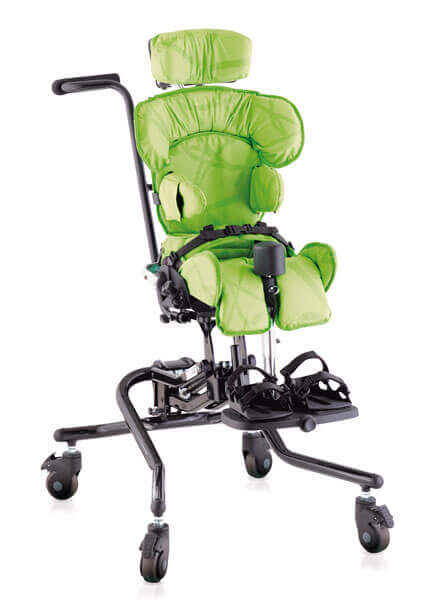 Leckey Squiggles Seating System
Leckey Squiggles Seating System
Why do we want a neutral pelvis?
The pelvis is usually considered the foundation of good positioning. This is because when it is out of alignment, the trunk and head will also become out of alignment. If stability is achieved using the upper extremities (arms and head), the child cannot perform other upper extremity skills such as coloring, writing, and feeding. Poor trunk alignment will lead to decreased respiration, digestion, and elimination. Poor head control can affect speech, swallowing, eye contact, and social interaction. It is amazing how just having the pelvis fall out of neutral can have so many negative impacts.
What positions do we see when the pelvis is not neutral?
When there is an asymmetric pull on the pelvis from muscle tone or muscle weakness, this can cause the pelvis to become asymmetrical. These positions are posterior pelvis tilt (+sagittal pelvic angle), anterior pelvic tilt (-sagittal pelvic angle), pelvic rotation (transverse pelvic angle), pelvic obliquity (front pelvic angle). Learn more with Education in Motion's Pelvic and Spinal Postures resource.
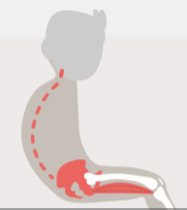 Posterior Pelvic Tilt
Posterior Pelvic Tilt
(+ sagittal pelvic angle)
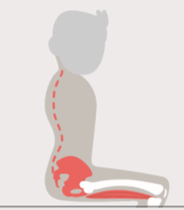 Anterior Pelvic Tilt
Anterior Pelvic Tilt
(- sagittal pelvic angle)
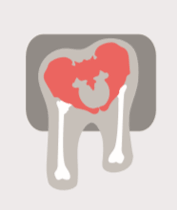 Pelvic Rotation
Pelvic Rotation
(transverse pelvic angle)
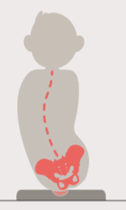 Pelvic Obliquity
Pelvic Obliquity
(frontal pelvic angle)
What are some of the causes of poor pelvic positioning?
If a child is in one position too long, it is unreasonable to expect that there would be no movement of the pelvis. We know that typically developing children are unable to sit in one position for very long; they can become restless, uncomfortable, or tired. Therefore, we should consider that a child with non-typical development will have the same issues.
Underlying conditions such as muscle tone and muscle tightness will also affect a child's tolerance to positioning. Common causes of pelvic asymmetries include abnormal tone in the trunk, muscle weakness or paralysis, tight muscles, decreased range of motion, and moving or sliding in the seat.
- Posterior pelvic tilt is often caused by low tone in the trunk, tight hamstrings, limited hip flexion, seat depth too long, and sliding.
- Anterior pelvic tilt is often caused by high tone in the trunk, weak abdominal muscles, tight paraspinal muscles, tight hip flexors, and tight quadriceps.
- Pelvic rotation is often caused by asymmetrical hip flexion, asymmetrical muscle tone, lower leg length discrepancy, and limitations in abduction or adduction range of motion.
- Pelvic obliquity is often caused by abnormal reflexes in the trunk, asymmetrical muscle tone, limited hip flexion, asymmetrical muscle strength, and asymmetrical range of motion.
It is important to perform a full mat assessment with the child in supine and in sitting to understand strength, tone, and limitations to range of motion. Then, determine the features that will benefit the child. Once the components are selected, the seating system recommendation can be made by choosing the one that can meet the child's needs the most. There are many seating systems on the market, so it is critical that the system chosen provides a method to maintain the pelvis in neutral so that the child has the best opportunity for function.
Learn more about Sunrise Medical's pediatric seating systems.
References
- Education in Motion (Ed.). (n.d.). Pelvic & Spinal Postures: Education in Motion. Sunrise Medical. https://www.sunrisemedical.com/education-in-motion/resources/seating/pelvic-and-spinal-postures.
- Gilmour, J., & Finney, L. (n.d.). Maximising Function: Pelvic Positioning Belts A review of evidence and best practice. Leckey Clinical. https://www.leckey.com/clinical.
- Lange, M. L., Lange, M. L., & Lange, A. M. L. (2018, September 7). 4 Common Problems with Wheelchair Pelvic Positioning-And Their Solutions. MedBridge Blog.